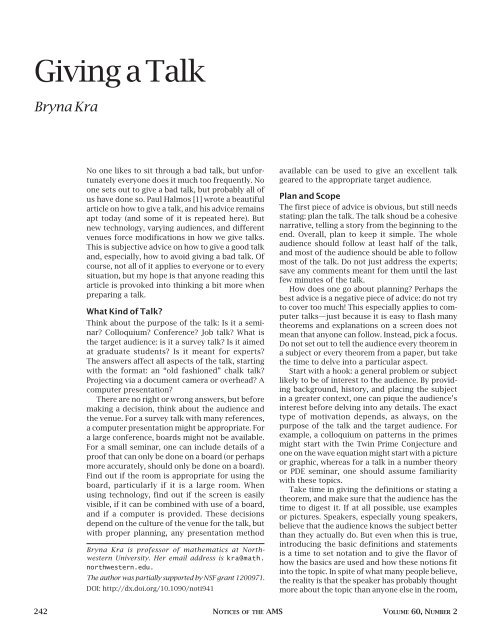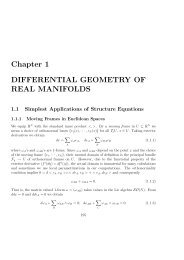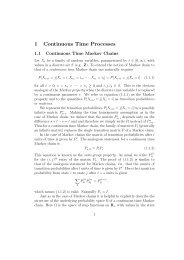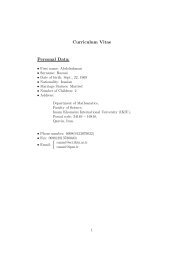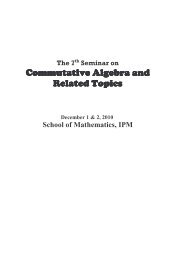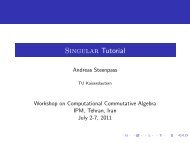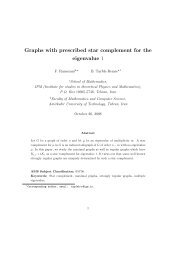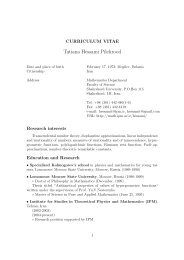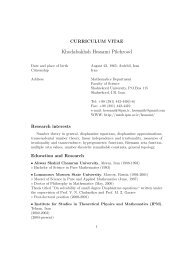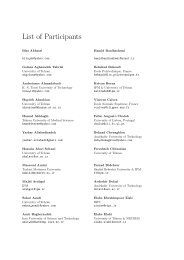Giving a Talk, B. Kra - Math - IPM
Giving a Talk, B. Kra - Math - IPM
Giving a Talk, B. Kra - Math - IPM
You also want an ePaper? Increase the reach of your titles
YUMPU automatically turns print PDFs into web optimized ePapers that Google loves.
<strong>Giving</strong> a <strong>Talk</strong><br />
Bryna <strong>Kra</strong><br />
No one likes to sit through a bad talk, but unfortunately<br />
everyone does it much too frequently. No<br />
one sets out to give a bad talk, but probably all of<br />
us have done so. Paul Halmos [1] wrote a beautiful<br />
article on how to give a talk, and his advice remains<br />
apt today (and some of it is repeated here). But<br />
new technology, varying audiences, and different<br />
venues force modifications in how we give talks.<br />
This is subjective advice on how to give a good talk<br />
and, especially, how to avoid giving a bad talk. Of<br />
course, not all of it applies to everyone or to every<br />
situation, but my hope is that anyone reading this<br />
article is provoked into thinking a bit more when<br />
preparing a talk.<br />
What Kind of <strong>Talk</strong>?<br />
Think about the purpose of the talk: Is it a seminar?<br />
Colloquium? Conference? Job talk? What is<br />
the target audience: is it a survey talk? Is it aimed<br />
at graduate students? Is it meant for experts?<br />
The answers affect all aspects of the talk, starting<br />
with the format: an “old fashioned” chalk talk?<br />
Projecting via a document camera or overhead? A<br />
computer presentation?<br />
There are no right or wrong answers, but before<br />
making a decision, think about the audience and<br />
the venue. For a survey talk with many references,<br />
a computer presentation might be appropriate. For<br />
a large conference, boards might not be available.<br />
For a small seminar, one can include details of a<br />
proof that can only be done on a board (or perhaps<br />
more accurately, should only be done on a board).<br />
Find out if the room is appropriate for using the<br />
board, particularly if it is a large room. When<br />
using technology, find out if the screen is easily<br />
visible, if it can be combined with use of a board,<br />
and if a computer is provided. These decisions<br />
depend on the culture of the venue for the talk, but<br />
with proper planning, any presentation method<br />
Bryna <strong>Kra</strong> is professor of mathematics at Northwestern<br />
University. Her email address is kra@math.<br />
northwestern.edu.<br />
The author was partially supported by NSF grant 1200971.<br />
DOI: http://dx.doi.org/10.1090/noti941<br />
available can be used to give an excellent talk<br />
geared to the appropriate target audience.<br />
Plan and Scope<br />
The first piece of advice is obvious, but still needs<br />
stating: plan the talk. The talk shoud be a cohesive<br />
narrative, telling a story from the beginning to the<br />
end. Overall, plan to keep it simple. The whole<br />
audience should follow at least half of the talk,<br />
and most of the audience should be able to follow<br />
most of the talk. Do not just address the experts;<br />
save any comments meant for them until the last<br />
few minutes of the talk.<br />
How does one go about planning? Perhaps the<br />
best advice is a negative piece of advice: do not try<br />
to cover too much! This especially applies to computer<br />
talks—just because it is easy to flash many<br />
theorems and explanations on a screen does not<br />
mean that anyone can follow. Instead, pick a focus.<br />
Do not set out to tell the audience every theorem in<br />
a subject or every theorem from a paper, but take<br />
the time to delve into a particular aspect.<br />
Start with a hook: a general problem or subject<br />
likely to be of interest to the audience. By providing<br />
background, history, and placing the subject<br />
in a greater context, one can pique the audience’s<br />
interest before delving into any details. The exact<br />
type of motivation depends, as always, on the<br />
purpose of the talk and the target audience. For<br />
example, a colloquium on patterns in the primes<br />
might start with the Twin Prime Conjecture and<br />
one on the wave equation might start with a picture<br />
or graphic, whereas for a talk in a number theory<br />
or PDE seminar, one should assume familiarity<br />
with these topics.<br />
Take time in giving the definitions or stating a<br />
theorem, and make sure that the audience has the<br />
time to digest it. If at all possible, use examples<br />
or pictures. Speakers, especially young speakers,<br />
believe that the audience knows the subject better<br />
than they actually do. But even when this is true,<br />
introducing the basic definitions and statements<br />
is a time to set notation and to give the flavor of<br />
how the basics are used and how these notions fit<br />
into the topic. In spite of what many people believe,<br />
the reality is that the speaker has probably thought<br />
more about the topic than anyone else in the room,<br />
242 Notices of the AMs VoluMe 60, NuMber 2
and even experts do not always remember all the<br />
definitions and basic theorems. Of course, one can<br />
go too far by including too many basics for the particular<br />
audience: for a talk in a dynamics seminar,<br />
there is no need to define the word ergodic, but<br />
one should in a colloquium.<br />
A good rule of thumb (other than for expository<br />
talks) is that at least half the talk should be<br />
devoted to the speaker’s own work. One should<br />
get to one’s own work as early as is practical—the<br />
earlier the better. If left to the last five minutes, the<br />
audience does not have time to absorb the material<br />
and pose questions.<br />
Everyone likes coming out of a talk having<br />
learned something, and the speaker should try<br />
to include some sort of proof, even in a general<br />
audience talk. It might be a very simple fact or a<br />
much simplified toy version of the real problem.<br />
If the talk is a seminar, it might be an outline of<br />
steps in a long proof or the proof of a crucial,<br />
technical lemma. If the statement or proof can be<br />
given in a simple case, do it. The audience does not<br />
need to hear the details of the most general setting<br />
in which the theorem can be proven and can<br />
instead be directed to the paper(s) concerning it.<br />
By avoiding the most general possible statement,<br />
much heavy (and incomprehensible) notation is<br />
also avoided. More important than the details is<br />
the motivation of the subject, an overview of the<br />
ideas, and the intuition behind them.<br />
<strong>Talk</strong>s are meant to convey something that is not<br />
in the literature and not just to be a repetition of<br />
the introduction of a recent article. A useful exercise<br />
is to think back to how the result was proven:<br />
what were false steps? What were examples used<br />
to test the ideas? Explaining such steps can be<br />
instructive components of a talk.<br />
For a seminar or typical conference talk, one<br />
theorem or a few related theorems are usually<br />
enough material. If the theorems covered naturally<br />
split into two different papers, then this is probably<br />
material for two separate talks. This does not<br />
mean that any result from another article ought to<br />
be omitted, but rather it should be used to bolster<br />
the main focus of the talk. Surveys are different:<br />
they should go slowly and have a goal but likely<br />
include many more (interrelated) topics.<br />
The last step of preparing a talk, particularly<br />
for inexperienced speakers, is practice. Practice<br />
the talk out loud and time it. Frequently, people<br />
are surprised to find that what they thought would<br />
be easy to fit into twenty minutes really takes<br />
forty-five minutes, or vice versa. Even experienced<br />
speakers benefit by saying all the words before<br />
the actual talk, even if each iteration is somewhat<br />
different. I still write every word that I plan to<br />
say, though I rarely refer to these extensive notes<br />
during the talk—just the exercise of thinking<br />
through the words improves the presentation.<br />
Citations and Thanks<br />
Make it clear which results are yours and which<br />
are in the literature. Give citations for any results<br />
used or previous results on the same topic; there<br />
is no need to give complete bibliographic listings,<br />
just the author(s) and year of publication suffice.<br />
Always thank the host or hosts for the invitation.<br />
Remember to cite any coauthors and anyone<br />
else who helped with the work.<br />
Computer <strong>Talk</strong>s<br />
The biggest change over the past ten years has<br />
been the proliferation of computer talks, leading<br />
to a host of self-created problems. The most basic<br />
problem is unreadable slides: the computer is not<br />
set up correctly for projection, the type is too<br />
small, or a slide is too crowded.<br />
The first of these problems is easily corrected<br />
with a few minutes of planning. Check in advance<br />
that the file works in full screen mode and know<br />
how to put the computer into this mode. If at all<br />
possible, try the file on the computer to be used<br />
during the talk. Before the talk begins, make sure<br />
to close any other programs running in the background,<br />
especially anything that might interrupt<br />
the presentation with a pop-up.<br />
The other two issues need to be addressed<br />
during the preparation of the talk. Simply put,<br />
computer talks do not work if the slides are too<br />
crowded. The type size has to be large, and it<br />
should be readable at the back of the room. This<br />
means that there is plenty of space between the<br />
lines and a maximum of about ten lines per slide<br />
(fewer is even better). Leave out as many words as<br />
possible and do not write full paragraphs. Beamer<br />
[2], a commonly used class for creating<br />
slides, as with most other presentation programs,<br />
comes with preset margins and spacings. They<br />
are designed so that one cannot put too much on<br />
a single slide, and there is no reason to override<br />
the settings.<br />
There is also no reason to put every word on<br />
the slide and then do nothing more than read it<br />
aloud—if that is the plan, just post the slides on a<br />
website and forget about giving the talk. It is better<br />
to have less on the slides and then use many<br />
words to explain what it all means. You should be<br />
able to state everything on a slide in less than a<br />
minute, but spend at least two to three minutes per<br />
slide fleshing out the explanations. Many excellent<br />
speakers spend five to six minutes per slide.<br />
A pointer or the mouse is useful for highlighting<br />
what the audience should focus on, but do not<br />
overdo it. Use it to highlight a particular object for<br />
a few seconds and then let the audience continue to<br />
look (or not) themselves. A bouncing laser pointer<br />
is a sure way to make the audience dizzy.<br />
Some speakers like to reveal the lines of a presentation<br />
one line at a time. But this means that the<br />
last line is visible for only a few seconds before it<br />
februAry 2013 Notices of the AMs 243
is replaced by a new page. It is often better to show<br />
the whole slide at once and let the audience see<br />
what is coming. To draw the audience’s attention<br />
to a particular statement, use the pointer, highlight<br />
the particular statement in another color (easy to<br />
do, for example, in Beamer), or use a lighter color<br />
to show the lower portions of the slide (again, easy<br />
in Beamer).<br />
Slides are great for repeating something that is<br />
needed more than once. But that does not mean<br />
scrolling back to an earlier slide out of order. Instead,<br />
include another slide that repeats the result,<br />
instantly reminding the audience exactly what is<br />
needed—this is one of the benefits of a computer<br />
presentation.<br />
Background graphics are almost always distracting.<br />
To get the audience to focus on the math,<br />
leave out the background of a beautiful sunset<br />
that obscures the equations and theorems. Some<br />
colors do not project well and should be avoided;<br />
particularly, many light colors do not work on rear<br />
projection screens. When in doubt, try the colors<br />
in advance on a real screen, not just on a small<br />
computer screen.<br />
On the other hand, when all the talks look the<br />
same, the audience begins to glaze over. Judicious<br />
use of color on slides can break up the monotony<br />
without being distracting. Pictures and graphics<br />
can enhance a talk, and when appropriate, animation<br />
is an excellent tool for explaining an idea or a<br />
proof. The animations should be embedded in the<br />
file and tested in advance—no one enjoys watching<br />
a speaker search through hundreds of files on<br />
a computer.<br />
Short <strong>Talk</strong>s<br />
Many conferences include short (twenty minutes<br />
or less) talks. Although one might think that these<br />
are easier to prepare, in some sense they are even<br />
harder. In twenty minutes, there is no time to<br />
present all the history, give a complete proof, or<br />
enter into the details of a construction. The goal<br />
is to convey a single result or several very closely<br />
related results, and this requires stripping out all<br />
other elements from the talk. Usually six to seven<br />
slides is more than enough for twenty minutes.<br />
Think of a twenty-minute talk as an extended<br />
movie trailer for the results: get the audience interested<br />
in finding out more.<br />
Most advice for short presentations is the same<br />
as that for longer ones, just compressed: the results<br />
should be placed in context, important earlier<br />
results should be cited, and there should be a hint<br />
as to the ingredients that enter the proof. Heavy<br />
notation and long statements should be avoided,<br />
even if this means that the general statement is<br />
omitted or the statements are less precise (so<br />
long as the imprecisions are made clear to the<br />
audience).<br />
Language Issues<br />
For nonnative English speakers, giving a talk in<br />
English can often be a significant hurdle, but<br />
there are several ways to make it easier. The first<br />
is to practice the talk, even multiple times, with<br />
or without an audience. It may be easier to use a<br />
computer for the presentation and use the slides<br />
as a memory tool for difficult words or phrases.<br />
If it is more appropriate to give a chalk talk, a<br />
handout can help by summarizing key points. Always<br />
remember to speak in full sentences and try<br />
to explain everything as much as possible.<br />
Pet Peeves<br />
This is a personal list of egregious errors that I<br />
have witnessed. Having said that, I am sure that I<br />
have committed each of these violations at some<br />
point, but these errors can be easily avoided:<br />
•Do not number your theorems. To refer back<br />
to a theorem, give it a memorable name, like the<br />
“Comparison Theorem” or the “Main Estimate”.<br />
No one can remember what Theorem 2 was, much<br />
less Theorem 8!<br />
•Do not use the same letter for two different<br />
purposes, even if this seems entirely natural. For<br />
example, if there is a map that is C 2 and a constant<br />
c, use k for the constant. Instead of using both a<br />
capital and lowercase version of a letter, such as<br />
φ and Φ, use different letters unless they are very<br />
closely linked. Otherwise, it is too hard to distinguish<br />
the two while talking, leading to awkward<br />
statements like “little φ” and “capital Φ”.<br />
•Do not introduce new definitions or a new<br />
topic in the last five minutes (the exception being<br />
a short talk). Instead, use this time to sum up main<br />
points, describe future directions, or address the<br />
experts.<br />
•Do not reveal your own insecurities with<br />
comments such as “my result is trivial” or “I would<br />
extend the result to case X, but I don’t understand<br />
X” or “I am sure everyone in the audience knows<br />
more about this.” Never belittle your own work, as<br />
there are many other people who would be happy<br />
to do this for you.<br />
Finishing Up<br />
Do not rush the talk, but do not go over. It is better<br />
to finish with a minute or two left rather than keep<br />
impatient people in their seats for extra time. Be<br />
prepared for questions at the end and leave time<br />
for the audience to ask them.<br />
Keep in mind that you, the speaker, know more<br />
about your work than the audience does. So relax,<br />
good luck, and enjoy yourself.<br />
References<br />
[1] Paul R. Halmos, How to talk mathematics, Notices<br />
Amer. <strong>Math</strong>. Soc. 21 (1974), 155–158.<br />
[2] http://en.wikipedia.org/wiki/Beamer ( ).<br />
244 Notices of the AMs VoluMe 60, NuMber 2


